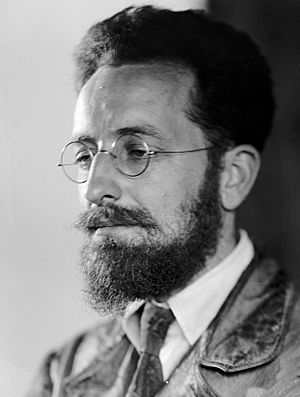Charles Seeger facts for kids
Quick facts for kids
Charles Seeger
|
|
|---|---|

Charles Seeger
|
|
| Background information | |
| Birth name | Charles Louis Seeger, Jr. |
| Born | December 14, 1886 Mexico City, Mexico |
| Died | February 7, 1979 (aged 92) Bridgewater, Connecticut, U.S. |
| Occupation(s) |
|
Charles Louis Seeger, Jr. (born December 14, 1886 – died February 7, 1979) was an American musicologist (someone who studies music), composer, teacher, and folklorist (someone who studies folk traditions). He was the father of famous American folk singers Pete Seeger (1919–2014), Peggy Seeger (born 1935), and Mike Seeger (1933–2009). His brother, Alan Seeger (1888–1916), was a poet who died in World War I.
Life and Music Journey
Charles Seeger was born in Mexico City, Mexico. His parents, Elsie Simmons and Charles Louis Seeger, were Americans. In the 1890s, his family lived in Staten Island, New York.
He graduated from Harvard University in 1908. After that, he went to Cologne, Germany, to study music and even conducted (led) the Cologne Opera. Charles later found out he had a hearing problem. Because of this, he left Europe and became a Professor of Music.
He taught at the University of California at Berkeley from 1912 to 1916. He left this job because he strongly disagreed with the U.S. joining World War I. Sadly, his brother Alan Seeger died in the war in 1916. Charles then taught at the Juilliard in New York from 1921 to 1933. He also taught at the New School for Social Research from 1931 to 1935.
Charles Seeger was very interested in how music is written. He also studied how people sing in different styles.
In 1933, he helped start the American Society for Comparative Musicology. This group studied music from different cultures. He also worked for the U.S. government from 1936 to 1953. He helped with music projects for groups like the Resettlement Administration and the Works Projects Administration (WPA). His wife also worked on some of these projects.
Later, he taught at the University of California Los Angeles (UCLA) from 1957 to 1961. From 1961 to 1971, he was a research professor there, studying Ethnomusicology (the study of music in different cultures). He also taught at Yale University for a year.
Charles Seeger passed away on February 7, 1979, in Bridgewater, Connecticut. He is buried in Springfield, Massachusetts.
His Family
Charles Seeger was married twice. His first wife was Constance de Clyver Edson. She was a classical violinist and teacher. They had three sons:
- Charles III (1912–2002), who became an astronomer.
- John (1914–2010), who was an educator.
- Pete Seeger (1919–2014), who became a very famous folk singer.
His second wife was the composer and musician Ruth Crawford Seeger. With her, he had four more children:
- Mike Seeger (1933–2009), also a folk musician.
- Peggy Seeger (born 1935), another well-known folk singer.
- Barbara Seeger.
- Penny Seeger (1943-1993).
His grandson, Anthony Seeger (born 1945), is an anthropologist (someone who studies human societies and cultures) and also teaches ethnomusicology at UCLA.
His Impact on Music
Charles Seeger is known for his ideas about music. He developed something called dissonant counterpoint. This is a way of writing music where different melodies sound "clashy" or "dissonant" on purpose.
A music expert named Bruno Nettl said that Charles Seeger was very important. He helped connect the study of music to other areas of culture. He was a "man for all seasons" because he knew so much about many different parts of music.
Images for kids


